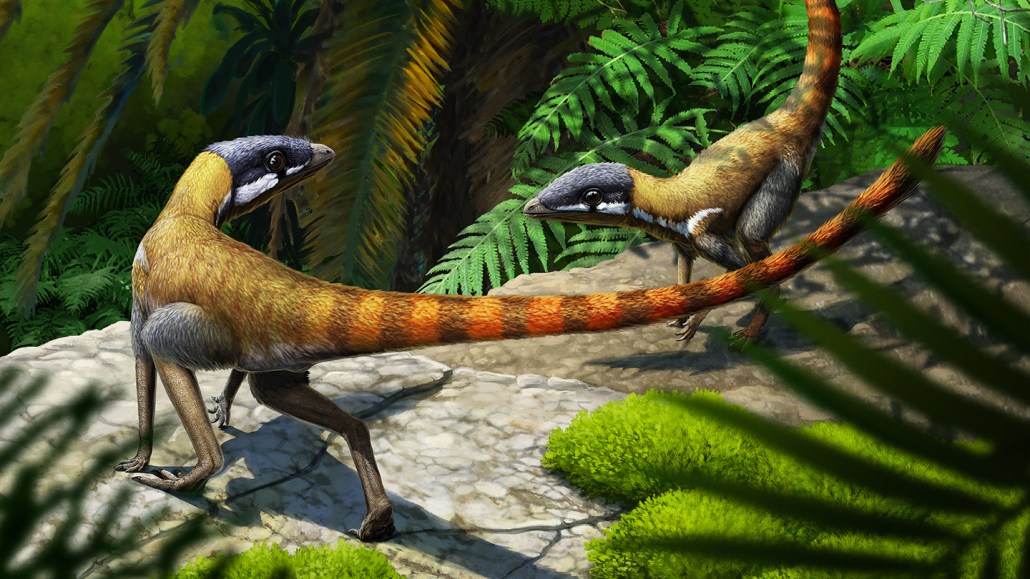Sprinting reptiles may have been forerunners of soaring pterosaurs
A fossil unearthed more than 100 years ago hints at how these early fliers evolved

Tiny Scleromochlus taylori, shown here in an artist’s rendition, was a two-legged, ground-dwelling reptile. It was a close relative of pterosaurs, the iconic winged vertebrates of the Age of Dinosaurs.
Gabriel Ugueto
Share this:
- Share via email (Opens in new window) Email
- Click to share on Facebook (Opens in new window) Facebook
- Click to share on X (Opens in new window) X
- Click to share on Pinterest (Opens in new window) Pinterest
- Click to share on Reddit (Opens in new window) Reddit
- Share to Google Classroom (Opens in new window) Google Classroom
- Click to print (Opens in new window) Print
A mysterious reptile unearthed more than 100 years ago now turns out to be part of a family of famous flyers.
This animal has been something of a mystery. Though tiny, it has long name: Scleromochlus taylori (Sklare-oh-MOK-lus TAY-lor-eye). It’s known entirely from fossils of seven individuals, discovered in 1907. Those fossils have been tricky to interpret. The bones were long gone. All that remained were impressions on the surrounding rock.
Yet many studies have described and redescribed S. taylori based on these fossils.
Those analyses suggested the animal’s closest kin might be dinosaurs, other reptiles or pterosaurs. (That last group were winged reptiles that lived alongside dinosaurs.) Now, researchers have discovered new details buried in the old fossils. These now suggest S. taylori was a close relative of pterosaurs. Pterosaurs were the first vertebrates to master powered flight.
The new finding lends support to the idea that pterosaurs evolved from tiny but swift two-legged ancestors.
Researchers knew that the little reptile, which lived about 230 million years ago, had an oddly shaped body. At less than 20 centimeters (8 inches) long, “it would fit on the palm of your hand,” says Davide Foffa. A paleontologist, he works at National Museums Scotland in Edinburgh. The animal’s head was very large for its body. It also had a short neck and long hind limbs. The rough outline wasn’t enough to identify the creature’s closest relatives, though. That task requires finer details of the skull and jaw — and the relative sizes of other body parts.
So Foffa and his colleagues turned to a technique called microcomputed tomography. It uses X-rays to scan an object without needing to cut into it. This allowed the team to collect once-inaccessible data from the fossils. The new data turned up new details, from the animal’s tail length to the shape of its jaw and size of its foot bones.
Some of the creature’s features — like its giant head — resemble those of pterosaurs. Others, like the orientation of the lower jaw, differ from those in pterosaurs. S. taylori didn’t seem adapted to flying, jumping or living in trees. Instead, it was probably a runner, the team concludes in the Oct. 13 Nature.

Fleet-footed reptiles
One of the most important new insights about S. taylori comes from its femur, or thighbone. It strongly resembles those in pterosaurs and lagerpetids. That second group was made up of small, ground-dwelling reptiles. In particular, the bottom of the femur, where it would connect to the lower leg, sported a structure that’s a hallmark of lagerpetids, Foffa says.
Lagerpetids didn’t fly. But recently, they and pterosaurs have been recognized as close relatives. And they both belonged to a group known as the pterosauromorphs (Tare-oh-SORE-oh-morfs). The common ancestor of that group was likely a small, fast-running reptile.
S. taylori has traits seen in both pterosaurs and lagerpetids. That hints it may be a very early lagerpetid — one that evolved soon after lagerpetids split off from the line that gained wings and took to the sky. Martín Ezcurra finds it “kind of a surprise” that S. taylori had so many traits seen in both lines. A paleontologist, Ezcurra works at the Argentine Museum of Natural Sciences in Buenos Aires. He did not take part in the new study. But he now agrees that the new study’s conclusion that S. taylori was an early lagerpetid makes a lot of sense.
Pterosaurs first appear in fossils from about 220 million years ago. Their anatomy is distinct. They had massive heads compared to their body sizes. Their wings had structures a bit like the fingers on human hands; the fourth one was very long. S. taylori had the big head, but its hands were still small, Ezcurra notes. There are no fossils of several animals that likely would have come midway between these animals and those with the features needed for flying, he says. But this new analysis of old fossils inches scientists closer to seeing where pterosaurs’ unique and flight-ready bodies emerged.
It’s difficult to say what such a proto-pterosaur might look like, says Hans Sues. He’s a paleontologist at the Smithsonian Institution in Washington, D.C., who wasn’t involved in the new study. “It is conceivable that a related small-bodied [reptile] climbed around in trees and eventually gave rise to a proto-pterosaur,” he says — perhaps as a glider.







